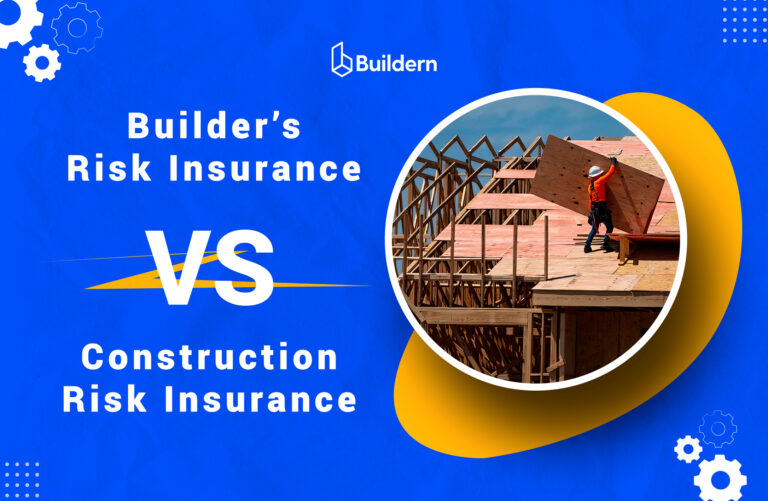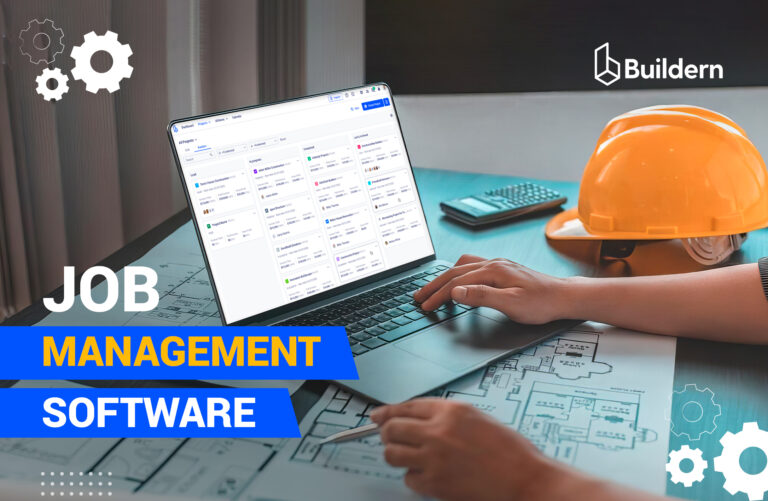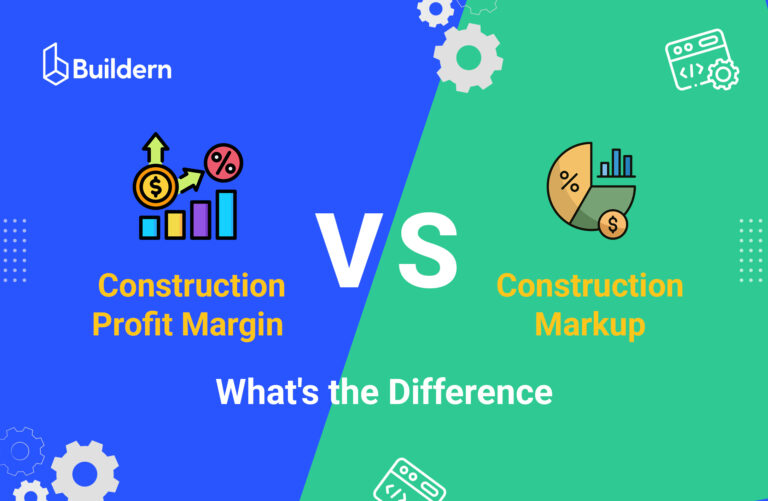How to Manage Construction Collaboration: 5 Field-Tested Strategies

Updated December 19
The fastest way for a project to slip off track is when we treat construction communication as an “extra” element of the construction process.
We often see construction teams operating unaware of what others are doing. The architect, the contractor, and the owner are all looking at a project from different angles. Construction collaboration is the coordinated sharing of project information, decisions, and responsibilities across owners, designers, contractors, and field teams.
Construction projects slip when communication becomes optional. Field teams, office staff, designers, and owners make decisions in parallel, and small gaps turn into rework, delays, and budget noise.
My article defines construction collaboration, explains the most common breakdowns, and shares five practical strategies you can apply to real projects
Table of Contents
- Why Collaboration Matters in Construction
- Collaboration Challenges in Construction
- Collaboration during Residential and Commercial Projects
- 5 Strategies to Improve Construction Collaboration
- Benefits of Effective Construction Collaboration
- Conclusion

Why Collaboration Matters in Construction
Construction projects are a team effort and therefore require careful coordination. It means all project stakeholders should be well-informed and in constant contact with each other.
As a project manager, I am coordinating the workflows between owners, architects, engineers, subcontractors, and crews working across different locations and timelines. Each group sees the project from a different angle. If there is no link, communication gaps quickly turn into big problems.
QUOTE: A common example happens between the field and the office. A subcontractor receives an updated scope or schedule change from the project manager, but the information doesn’t reach the crew on-site in time.
The team proceeds with the original plan, and the issue is only discovered days later. The result is rework, wasted materials, and project delays that could have been avoided with better collaboration.
Recommended reading:
Collaboration Challenges in Construction
To understand the real challenges, it’s essential to recognize that the scope and type of the project add difficulty. Let me list some of the challenges that any contractor is familiar with. By the way, these challenges rarely happen in isolation. On most projects, several of them overlap and compound each other.
Misalignment between teams: Office staff, site crews, and subcontractors often work with different priorities or incomplete information.
Scattered documentation: Plans, drawings, and approvals spread across emails, spreadsheets, or jobsite notes create confusion.
Ineffective communication channels: Messages may be missed or misinterpreted when relying on multiple tools (calls, chats, texts, emails).
Change management difficulties: Scope changes or design updates may not be shared promptly.
Conflicting expectations: Clients, subcontractors, and crews may have different understandings of timelines, responsibilities, and deliverables.
Delayed approvals and decisions: Waiting for sign-offs on submittals or selections can halt progress.
Technology skills gaps: Team members may have different levels of experience with project management tools or digital documentation.
Collaboration during Residential and Commercial Projects
In residential construction, collaboration challenges usually are about client communication and managing client expectations.
Homeowners are actively involved in selections, scope changes, and approvals, which often lead to frequent revisions. When these updates are not clearly documented and shared with subcontractors and site crews, misunderstandings arise.
In commercial construction, collaboration becomes even more complex due to the number of stakeholders involved. Design team, multiple subcontractors, inspectors, and owner representatives must coordinate their work. One of the most common pain points is the management of submittals that undergo multiple review stages.
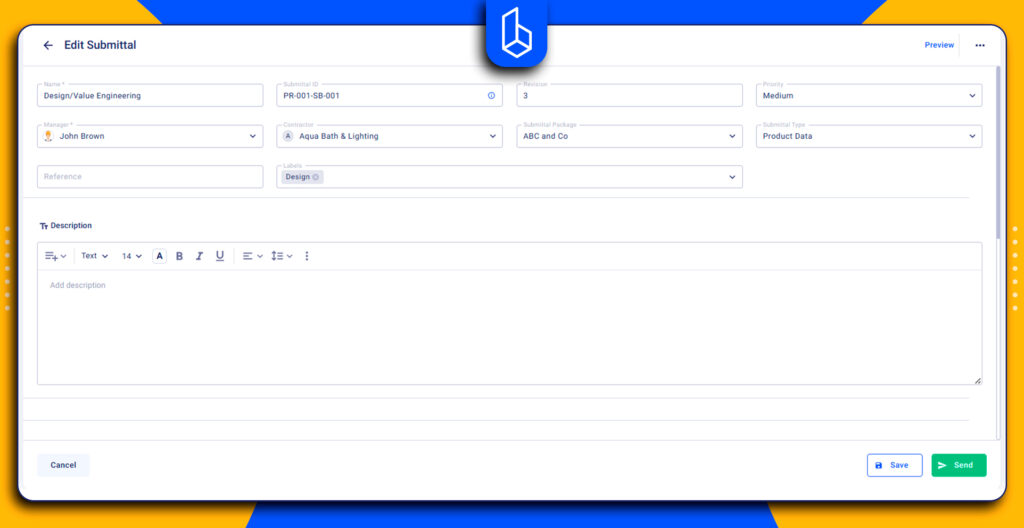
5 Strategies to Improve Construction Collaboration
Even with the best intentions, construction projects can go in the wrong direction when teams aren’t fully aligned. Here are my practical tips on how to create a collaborative environment that keeps projects moving smoothly.
#1 Engage Stakeholders Early
Goal: Align scope, roles, and the decision process before execution starts.
What to do?
- Run a kickoff with the owner or owner rep, architect or designer, PM, superintendent, and key subs.
- Confirm scope boundaries (inclusions/exclusions), sequencing assumptions, constraints, and long lead items.
- Assign decision owners: who approves selections, submittals, and changes.
- Set escalation paths for issues (field to superintendent to PM to designer to owner).
- Agree on frequency (weekly meeting, daily check in) and what must be documented after each touchpoint.
Example: A residential project starts with a selections timeline and named approvers, so trades do not wait on unclear ownership or install items that are not finalized.
The success signals are fewer early change orders, fewer RFIs in the first third of the project, faster decisions during week one to four.
#2 Centralize Project Information
Goal: Create a single source of truth so the team executes from the latest approved information.
Centralize:
- Latest drawings and specs with version control
- Approved scope and contract documents
- Schedule and milestone dates
- Selections and finish schedules with approval history
- Photos, field reports, key contacts
- Change orders and the current approved state of work
Example: a client finalizes their selections for flooring and fixtures. A project manager would need to relay this information separately to each subcontractor, and crews on-site might still be unsure which materials to install. Using such tools as a dedicated portal, however, all updates are posted once in a single, accessible location.
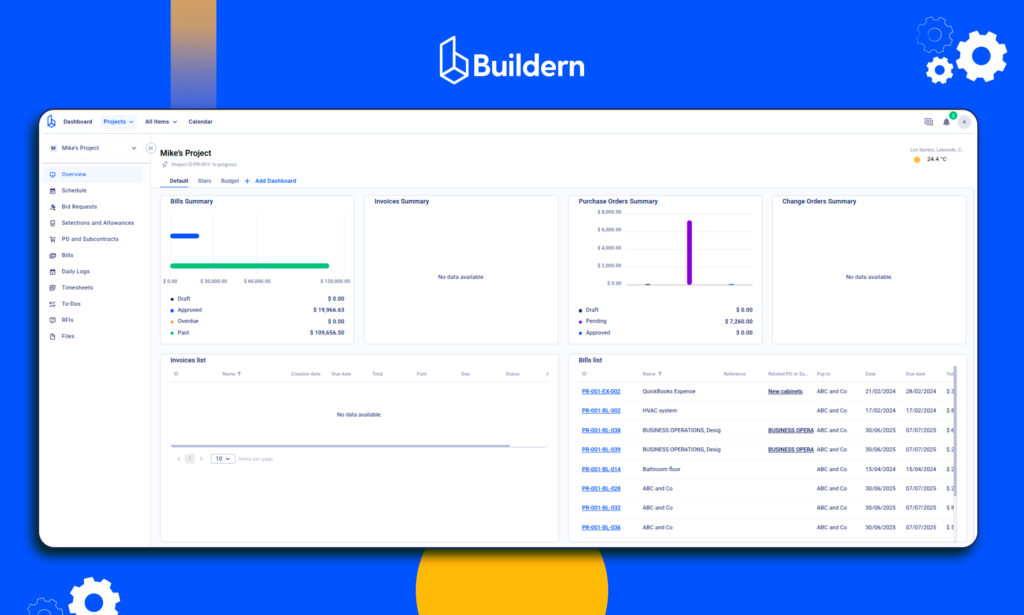
Clients also benefit from a dedicated portal. Changes are automatically recorded, so there’s a clear history of who approved what and when.
Success signals: Fewer “outdated plan” mistakes, fewer repeated client questions about approvals, faster onboarding for new subs.
For a deeper look at client-side coordination, see our guide on client communication for custom home builders.
#3 Keep Communication Clear
Goal: Ensure questions get answered fast and decisions are visible to everyone who must act.
Standardize communication to have:
- One primary place for project questions and updates
- One path for urgent site blocking issues
Using a structured messaging system, teams can post updates or questions in one place where the right people (field crew or office team) see them in real time.
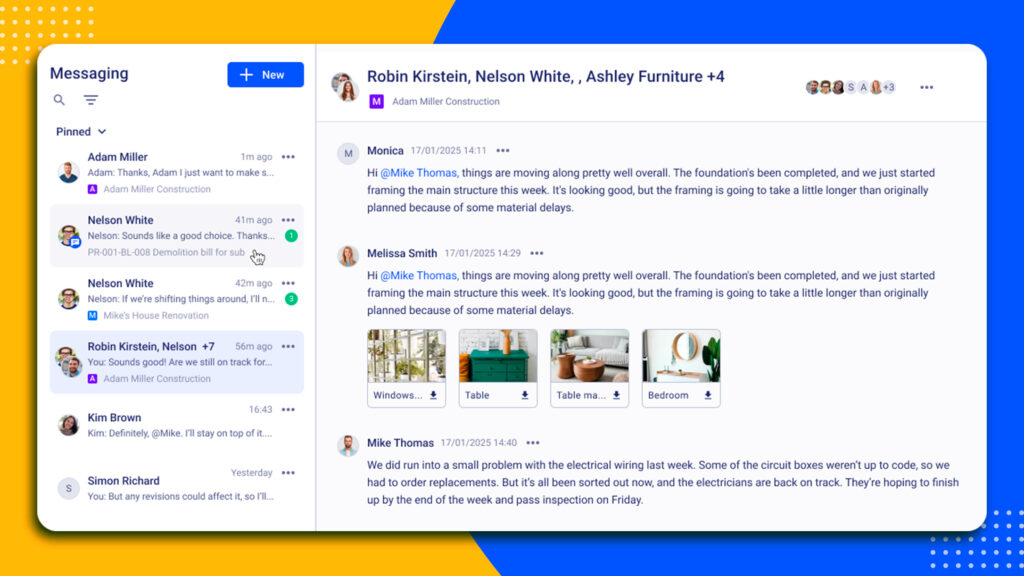
Clients also benefit from this approach. When they see timely answers, comments, and clear updates from the contractor, it reassures them that the project is under control. Even small delays in responses can create unnecessary anxiety.
Example: A subcontractor posts an install question in the project thread, the right owner responds, and the final answer is pinned to the related task or drawing reference.
Success signals are shorter time from question to answer, fewer repeated clarifications, fewer delays caused by waiting on direction.
#4 Use Mobile and Intuitive Tools
Goal: Make collaboration usable on site so field teams see updates immediately and can report progress fast.
Prioritize jobsite usability:
- Fast access to the latest drawing and today’s tasks
- Low signal resilience and simple navigation
- Photos and notes tied to a task, location, or drawing detail
- Push notifications for revisions, schedule changes, approvals, and change orders
The crews need to see updates whether they’re on-site, at a supplier’s warehouse, or meeting with a client. Mobile-friendly tools make this possible.
Optional but practical tips:
Even on-site, QR codes can make documents, material information, or tasks instantly reachable for field crews. Scanning a QR code to pull up the latest drawing or task list ensures the work aligns with the approved plan.
Example: A crew scans a QR code and opens the latest approved install detail before starting work, preventing a revision miss.
Success signals are higher field adoption, fewer “I did not see the update” issues, faster closeout on punch items.

#5 Document Changes in Due Time
Goal: Control scope changes in real time so the field executes the approved plan and the budget stays accurate.
Minimum workflow:
- Capture the request immediately
- Define scope change clearly
- Assess cost and schedule impact
- Get approval before execution
- Publish updated instructions and notify affected trades
Example: A client changes countertop material mid-project. The PM records it the same day, gets approval, updates the selection in the central system, and notifies purchasing and the install trade, so nobody proceeds on the original spec.
By documenting the change order in real time and sharing it with the subcontractor through a centralized system. The project manager ensures the crew has the correct materials and instructions, and the client sees that their request has been acknowledged and scheduled.
Success signals: Fewer scope disputes, fewer surprise overruns late in the project, and reduced rework from uncommunicated changes.
Benefits of Effective Construction Collaboration
Though it might require extra resources and energy to bring smooth collaboration to your construction project, the rewards will make it worth.
Fewer Changes and Rework
Rework can cost the construction industry billions and can damage relationships between owners and contractors. Therefore, strong collaboration from the beginning can drastically decrease the need for rework.
In the case of a residential build, a homeowner is better off engaged in the construction project planning stage from the very start.
Better Understanding of a Project
There is a big difference between a team blindly executing its work and a team that understands how its tasks fit into the larger project goal. The latter team is far more effective in achieving the desired results. However, this requires a high level of communication and collaboration.
When working with the construction management software, there is no miscommunication and a fear that someone from the team will not be aware of the current status of work.
For instance, the software tool’s dashboard indicates whether any changes are confirmed or are currently awaiting approval.
Healthy Environment
A smart contractor needs to create a healthy working environment for the construction team that will further improve team productivity. A collaborative culture encourages the team to use their full potential to reach common goals.
Recommended reading:
Better Brand Reputation
In the residential construction industry, brand reputation is crucial. Who would trust their home building or home renovation to a company that failed to meet the expectations of many clients before?
Proving there is a simple workflow with many tools to stay in constant contact with a project owner helps construction companies maintain a strong reputation in the field.
In the end of the day, better partner relationships and timely delivery of projects lead to an extensive network of clients. They give positive feedback about your services and expertise and promote your company in the market.
Conclusion
When you consider what makes construction projects successful, let effective collaboration be the first that comes to mind.
Among many other factors contributing to a construction project’s success, people standing behind it remain the core value that should not be overlooked. Therefore, creating a collaborative environment for the team can make a great difference in how you launch, implement, and deliver your projects!

What Is Collaboration in Construction?
Collaboration is a vital element of any construction process where tasks overlap, and different trades are mixed. It involves the process of coordinating people, information, and workflows across the entire project team.
Who Is Responsible for Collaboration on a Project?
Collaboration on a construction project is a shared responsibility, but it is typically led by the project manager or general contractor. They set communication standards and coordinate the workflow between the office and field crews.
How to Measure Construction Collaboration Success?
If rework and project delays are within acceptable limits, it’s often a strong indicator that teams are aligned and information is flowing properly. Other signs of successful collaboration include fewer last-minute change orders and a fast approval workflow.
